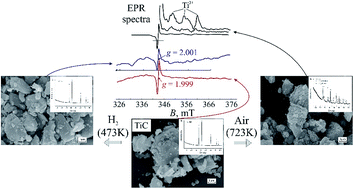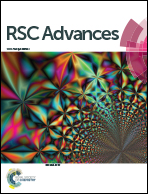Structural transformation and nature of defects in titanium carbide treated in different redox atmospheres
Abstract
The defect structure and phase formation processes occurring in the bulk and on the surface of titanium carbide (TiC) under thermal treatment in different ambient atmospheres (air, hydrogen, vacuum) were characterized using XRD, SEM, EPR, XPS and IR-spectroscopy. The oxidized states of both titanium (TiO2−x) and carbon, in the form of carbonate–carboxylate structures (O–C![[double bond, length as m-dash]](https://www.rsc.org/images/entities/char_e001.gif) O), were found on the surface of untreated TiC. Carbon vacancies were detected as paramagnetic defects in the crystalline lattice of TiC. The heat treatment of TiC in reducing conditions leads to an increase of the electrical conductivity associated with the formation of structural defects. Annealing of TiC in air causes its oxidation with the formation of an anatase-type TiO2 phase. Paramagnetic defects typical of both TiC and TiO2−x were revealed.
O), were found on the surface of untreated TiC. Carbon vacancies were detected as paramagnetic defects in the crystalline lattice of TiC. The heat treatment of TiC in reducing conditions leads to an increase of the electrical conductivity associated with the formation of structural defects. Annealing of TiC in air causes its oxidation with the formation of an anatase-type TiO2 phase. Paramagnetic defects typical of both TiC and TiO2−x were revealed.



 Please wait while we load your content...
Please wait while we load your content...